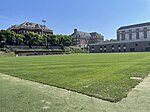Premier Health Miami Valley Hospital

Premier Health Miami Valley Hospital is a large urban hospital in Dayton, Ohio, and is a member of the Premier Health Partners network. The hospital has two additional locations; Miami Valley Hospital South in Centerville, Ohio, and Miami Valley Hospital North in Englewood, Ohio. It has the Dayton region's only Level I Trauma Center, a regional adult burn center, and a level 3 neonatal intensive care unit. Miami Valley Hospital has 7,370 employees and 970 beds, and saw over 400,000 outpatient visits in 2007. Miami Valley Hospital's emergency and trauma center contains 72 beds and is the busiest emergency department in Ohio. Miami Valley Hospital also operates three air ambulances known as CareFlight. Miami Valley Hospital is a top 100 hospital in the United States for clinical excellence. The hospital also holds numerous awards from HealthGrades, Forbes, and U.S. News & World Report. The Boonshoft School of Medicine at Wright State University is the affiliated university. It also holds recognition as a Magnet hospital, the highest distinction in nursing. It gained its first designation in 2019. https://www.nursingworld.org/organizational-programs/magnet/find-a-magnet-organization/
Excerpt from the Wikipedia article Premier Health Miami Valley Hospital (License: CC BY-SA 3.0, Authors, Images).Premier Health Miami Valley Hospital
Wyoming Street, Dayton
Geographical coordinates (GPS) Address Phone number Website External links Nearby Places Show on map
Geographical coordinates (GPS)
| Latitude | Longitude |
|---|---|
| N 39.7448 ° | E -84.186 ° |
Address
Miami Valley Hospital
Wyoming Street 1
45409 Dayton
Ohio, United States
Open on Google Maps







